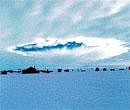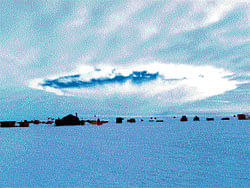

Many times, these holes were mistaken for mysterious unidentified flying objects (UFOs), even though they are actually caused by airplanes flying through clouds. Now, researchers say, this phenomenon can lead to increased snowfall around many major airports around the world. The findings were published in the July 1 issue of the journal Science.
As airplanes fly through the clouds, they often punch holes through the ones that contain super cooled water, or water that has remained in liquid form below its freezing point.
The effect is similar to cloud seeding. Numerous private and commercial flights have been drilling holes and canals through clouds all along and in the process influencing the snow and rainfall below them. Led by scientists from National Center for Atmospheric Research, the new research focuses on these hole punch and canal clouds that form when planes fly through certain mid-level clouds, forcing nearby air to rapidly expand and cool.
This, the scientists said, might result in more snow fall near airports compelling the authorities to de-ice the planes more. The consequences would be more pronounced in mid-and high-latitudes rather than a tropical country like India. Piercing of the cloud causes water droplets to freeze to ice and then turn to snow as they fall toward the ground, leaving behind odd-shaped gaps in the clouds. “Whether an airplane creates a hole or a canal in the clouds depends on its trajectory. When they climb through a super-cooled cloud layer, they can just produce a hole. But when they fly level through the cloud layer, they can produce long canals,” said NCAR scientist Andrew Heymsfield who led the study.
Images from NASA’s satellite
The team used images from NASA’s CALIPSO satellite and weather forecasting models to examine how often this type of inadvertent cloud seeding may occur within 62 miles (100 kilometers) of six commercial airports: London Heathrow, Frankfurt, Charles De Gaulle (Paris), Seattle-Tacoma, O'Hare (Chicago), and Yellowknife (Northwest Territories, Canada), as well as Byrd Station in Antarctica.
They chose the 62-mile radius because that approximately is the distance it takes for a commercial aircraft to climb above about 10,000 feet, where many of the super-cooled cloud layers are located.
The researchers found depending on the airport and type of plane, right atmospheric conditions typically exist up to six per cent of the time in a year, with somewhat more frequency in colder climates. The cloud-seeding effects are more pronounced near the polar region rather than tropics. “It appears to be a rather widespread effect for aircraft to inadvertently cause a measurable amount of rain or snow as they fly through certain clouds. This is not necessarily enough precipitation to affect global climate, but it is noticeable around major airports in the mid-latitudes,” he said.
For India, the effects may be negligible. “The effects in India are probably minimal in terms of precipitation enhancement. In the summer monsoon, there may be more precipitation generated aloft but would be small in comparison to what would be occurring naturally. And it’s too hot to snow,” Heymsfield told Deccan Herald.
The researchers did not estimate the total amount of rain or snow that would result from such inadvertent cloud seeding. However, they analysed radar readings that, in one case, indicated a snowfall rate of close to an inch an hour after several planes had passed through.
Punching a hole in the clouds
For decades, scientists speculated about the origins of mysterious holes and canals in clouds. Often they are mistaken for UFO because of the cloud-hole shape and its stability. An extensive cloud layer over Texas on January 29, 2007, persisted for more than four hours and reached lengths of 60 miles or more. Heymsfield led a study last year establishing that the gaps, which sometimes look as a giant hole punch are caused when aircraft fly through midlevel clouds that contain super-cooled droplets.
“The 2009 Moscow UFO is likely a hole punch cloud. The only difference is that the top of the hole was likely to have been covered by overcast,” he said.
When a turboprop plane flies through such a cloud layer with an average temperature of minus 15 degrees Celsius or lower, the tips of its propellers can cause the air to rapidly expand. As the air expands, it cools and causes the super-cooled droplets to freeze into ice particles that evaporate the droplets and grow falling out of the clouds as snow or rain. Jet aircraft need colder temperatures (about minus 20 to 25 degrees C) to generate the seeding effect. Air is forced to expand over the wings as the aircraft moves forward cools and freezes the cloud droplets. The effect is unrelated to the trails of condensed water vapour known as contrails made by the exhaust of jet engines.
Perfect for precipitation
Frankfurt, DeGaulle, and O’Hare airports experienced the right conditions for propeller aircraft to generate precipitation most frequently. In each case, the conditions existed more than five per cent of the time in a year while similar conditions existed about three per cent time for jets at Heathrow, Frankfurt, and Seattle-Tacoma.
Yellowknife experienced such conditions about 10 per cent of the time for propeller planes and five percent for jets, presumably because of colder cloud conditions at higher latitudes. Byrd often experienced the very cold conditions that enable jets to cause inadvertent cloud seeding.
A diverse range of aircraft, commercial jets (Boeing 757s and MD-80 series of jets), military aircraft (B-52s), regional and private jets, turboprops, and prop/piston planes, can induce precipitation.
“It appears virtually any airplane that flies through clouds containing liquid water at temperatures much below freezing can cause this effect,” Heymsfield says.
